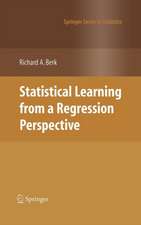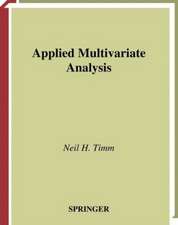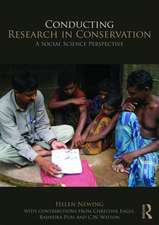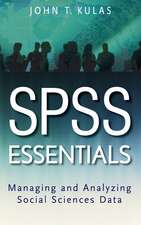Sociology and Complexity Science: A New Field of Inquiry: Understanding Complex Systems
Autor Brian Castellani, Frederic William Haffertyen Limba Engleză Hardback – 4 feb 2009
| Toate formatele și edițiile | Preț | Express |
|---|---|---|
| Paperback (1) | 640.55 lei 43-57 zile | |
| Springer Berlin, Heidelberg – 22 oct 2010 | 640.55 lei 43-57 zile | |
| Hardback (1) | 647.40 lei 43-57 zile | |
| Springer Berlin, Heidelberg – 4 feb 2009 | 647.40 lei 43-57 zile |
Din seria Understanding Complex Systems
- 18%
 Preț: 1112.30 lei
Preț: 1112.30 lei -
 Preț: 439.25 lei
Preț: 439.25 lei - 18%
 Preț: 1119.38 lei
Preț: 1119.38 lei - 15%
 Preț: 401.82 lei
Preț: 401.82 lei - 18%
 Preț: 1247.26 lei
Preț: 1247.26 lei - 15%
 Preț: 641.20 lei
Preț: 641.20 lei - 15%
 Preț: 642.68 lei
Preț: 642.68 lei - 15%
 Preț: 651.51 lei
Preț: 651.51 lei - 18%
 Preț: 946.55 lei
Preț: 946.55 lei - 18%
 Preț: 947.98 lei
Preț: 947.98 lei - 20%
 Preț: 650.27 lei
Preț: 650.27 lei - 18%
 Preț: 952.09 lei
Preț: 952.09 lei - 18%
 Preț: 957.13 lei
Preț: 957.13 lei - 18%
 Preț: 943.88 lei
Preț: 943.88 lei -
 Preț: 398.35 lei
Preț: 398.35 lei - 5%
 Preț: 1417.54 lei
Preț: 1417.54 lei - 15%
 Preț: 648.42 lei
Preț: 648.42 lei -
 Preț: 387.75 lei
Preț: 387.75 lei - 18%
 Preț: 1133.76 lei
Preț: 1133.76 lei - 18%
 Preț: 948.16 lei
Preț: 948.16 lei - 20%
 Preț: 655.85 lei
Preț: 655.85 lei - 18%
 Preț: 1113.09 lei
Preț: 1113.09 lei - 20%
 Preț: 655.53 lei
Preț: 655.53 lei - 15%
 Preț: 653.00 lei
Preț: 653.00 lei - 18%
 Preț: 1332.92 lei
Preț: 1332.92 lei - 18%
 Preț: 1010.48 lei
Preț: 1010.48 lei - 18%
 Preț: 955.56 lei
Preț: 955.56 lei -
 Preț: 384.22 lei
Preț: 384.22 lei - 18%
 Preț: 950.66 lei
Preț: 950.66 lei - 15%
 Preț: 638.43 lei
Preț: 638.43 lei - 15%
 Preț: 644.49 lei
Preț: 644.49 lei - 15%
 Preț: 649.06 lei
Preț: 649.06 lei - 15%
 Preț: 639.25 lei
Preț: 639.25 lei - 15%
 Preț: 643.65 lei
Preț: 643.65 lei - 18%
 Preț: 960.78 lei
Preț: 960.78 lei - 15%
 Preț: 649.87 lei
Preț: 649.87 lei - 15%
 Preț: 645.47 lei
Preț: 645.47 lei
Preț: 647.40 lei
Preț vechi: 761.65 lei
-15% Nou
Puncte Express: 971
Preț estimativ în valută:
123.90€ • 128.87$ • 102.28£
123.90€ • 128.87$ • 102.28£
Carte tipărită la comandă
Livrare economică 14-28 aprilie
Preluare comenzi: 021 569.72.76
Specificații
ISBN-13: 9783540884613
ISBN-10: 3540884610
Pagini: 300
Ilustrații: XV, 277 p. 9 illus.
Dimensiuni: 155 x 235 x 22 mm
Greutate: 0.61 kg
Ediția:2009
Editura: Springer Berlin, Heidelberg
Colecția Springer
Seria Understanding Complex Systems
Locul publicării:Berlin, Heidelberg, Germany
ISBN-10: 3540884610
Pagini: 300
Ilustrații: XV, 277 p. 9 illus.
Dimensiuni: 155 x 235 x 22 mm
Greutate: 0.61 kg
Ediția:2009
Editura: Springer Berlin, Heidelberg
Colecția Springer
Seria Understanding Complex Systems
Locul publicării:Berlin, Heidelberg, Germany
Public țintă
ResearchCuprins
SACS Toolkit#x2014;Theoretical Framework.- SACS Toolkit#x2014;Assemblage.- Overview of SACS.- Environmental Forces.- Five Areas of Research.- The System of SACS.- SACS Today.- Conclusion.- Mapping Complexity.
Recenzii
From the reviews:“This ambitious book is an effort to provide a comprehensive overview of the research and people making up the rapidly expanding area … ‘Sociology and Complexity Science’ (SACS). SACS refers broadly to the community of sociologists and like-minded scholars … in social research. … does a very nice job of tracing out the evolution of this field, and its antecedents in other areas of research. It may be best suited to someone … interested in learning more about the area and its development.” (Elizabeth Bruch, Journal of Artificial Societies and Social Simulation, Vol. 13 (1), 2010)
Textul de pe ultima copertă
This book is the first to identify and review the new field of study, sociology and complexity science—or SACS for short. SACS is comprised of five cutting-edge areas of research: computational sociology, the British-based School of Complexity (BBC), complex social network analysis (CSNA), sociocybernetics and the Luhmann School of Complexity (LSC). Together, these five areas represent the latest development in complexity science and sociological systems thinking, offering researchers a powerful, new set of tools for addressing the growing complexity of sociological inquiry.
This book also showcases a new method for modeling social systems, called the SACS Toolkit. The SACS Toolkit comes with a theoretical framework (social complexity theory), procedural algorithm (assemblage) and recommended toolset for modeling social systems (qualitatively, historically or numerically) from the ground-up. In fact, this book uses the SACS Toolkit to review the new field of SACS.
The third feature of this book is its compendium of maps, graphs and figures—all located in one chapter. Demonstrating the visual ingenuity of complexity science method, this compendium provides a picture-book tour of the new field of SACS.
Finally, this book comes with a companion website—an internet resource for exploring the new science of complexity and its intersection with sociology; and for downloading the maps (in color) used in this book. Useful for teachers, students and researchers, this book articulates a possible future for social scientific inquiry in the 21st century.
This book also showcases a new method for modeling social systems, called the SACS Toolkit. The SACS Toolkit comes with a theoretical framework (social complexity theory), procedural algorithm (assemblage) and recommended toolset for modeling social systems (qualitatively, historically or numerically) from the ground-up. In fact, this book uses the SACS Toolkit to review the new field of SACS.
The third feature of this book is its compendium of maps, graphs and figures—all located in one chapter. Demonstrating the visual ingenuity of complexity science method, this compendium provides a picture-book tour of the new field of SACS.
Finally, this book comes with a companion website—an internet resource for exploring the new science of complexity and its intersection with sociology; and for downloading the maps (in color) used in this book. Useful for teachers, students and researchers, this book articulates a possible future for social scientific inquiry in the 21st century.
Caracteristici
Surveys all the major areas involved in the integration of sociology and complexity science Useful for researchers in complexity and sociologists Presenting real life application of the theory of complex nonlinear systems to sociology Includes working concepts and a companion website














